Panel Offers Living Systems Approach to Design
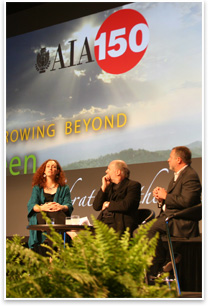 Summary: “The current scale and the types of human activity are producing impacts that are exceeding biological production and assimilative capabilities of the planet,” declared moderator Ray Cole, professor and director of the School of Architecture and Landscape Architecture at the University of British Columbia. “We are harming the planet’s ability to sustain life.” Cole served as moderator for the Friday theme session panel of South African architect Chrisna du Plessis and American architect William Reed, AIA. Cole set the panel agenda to address how human and natural systems can co-evolve in a positive and enriching manner—as well as the new realities–new expectations, new requirements, and new responsibilities—that architects face. Summary: “The current scale and the types of human activity are producing impacts that are exceeding biological production and assimilative capabilities of the planet,” declared moderator Ray Cole, professor and director of the School of Architecture and Landscape Architecture at the University of British Columbia. “We are harming the planet’s ability to sustain life.” Cole served as moderator for the Friday theme session panel of South African architect Chrisna du Plessis and American architect William Reed, AIA. Cole set the panel agenda to address how human and natural systems can co-evolve in a positive and enriching manner—as well as the new realities–new expectations, new requirements, and new responsibilities—that architects face.
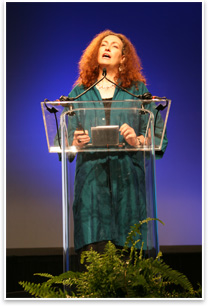 Du Plessis calls for a “new story” Du Plessis calls for a “new story”
“As a lover of nature and advocate of sustainable development who lives on the poorest continent on the globe, I am caught in the horns of a dilemma familiar to everyone who works in the so-called developing countries,” said du Plessis, who serves as principal researcher at the Council for Scientific and Industrial Research, one of the leading scientific and technology research, development, and implementation organizations in Africa. The standard calls for actions that are already familiar to most architects:
- Reduce, reuse, recycle
- Simplify your life
- Improve performance and efficiency.
These standards, however, apply to only a fraction of the people in developing countries and the buildings they build, she explained. In the world where she works, the choices are not about reducing excessive consumption. Du Plessis therefore has made it her personal quest to find a path that allows us to provide a decent quality of life with clean water and energy, proper shelter, and proper nutrition to millions of people who currently don’t have them—without engaging in further large-scale environmental destruction.
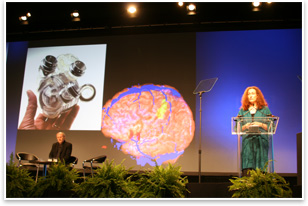 Du Plessis noted that Thomas Berry, in The Dream of the Earth, said that we are between stories, and that the old story of the account of how we fit into the world is no longer effective. We still have to find and learn a new story, she said. “Most of us were brought up with the story that humans are somehow outside of this wild thing called nature, and that it is there for our use; that we have an obligation to tame it, control it, subjugate it. For that, we think, is development. This translates to a separation from our own wild nature, a separation that tells us that even the deep mysteries of life can be explained, and that any problem can be solved by inventing a technology to fix the part that is broken.” Du Plessis noted that Thomas Berry, in The Dream of the Earth, said that we are between stories, and that the old story of the account of how we fit into the world is no longer effective. We still have to find and learn a new story, she said. “Most of us were brought up with the story that humans are somehow outside of this wild thing called nature, and that it is there for our use; that we have an obligation to tame it, control it, subjugate it. For that, we think, is development. This translates to a separation from our own wild nature, a separation that tells us that even the deep mysteries of life can be explained, and that any problem can be solved by inventing a technology to fix the part that is broken.”
Echoing the thoughts of David Suzuki, du Plessis suggested that our new story should be that: “All of reality is a field of interacting forces and everything that exists is called into being through the interactions of these forces … this means that we have to start cultivating a whole new way of thinking that creates a world of wholeness, of belonging and interdependence, of participation and reciprocation, and of humble co-creation and co-evolution ... What ties together our story is the responsibility and humility we have to bring to whatever actions we take not just as architects, but also as members of the great web of life.” Du Plessis concluded with a question: “How does this relate to everyday architecture practice?” She turned to fellow speaker Bill Reed as a “pioneer who in his practice is already living the story and can show us the way.”
We have to start cultivating a whole new way of thinking that creates a world of wholeness, of belonging and interdependence, of participation and reciprocation, and of humble co-creation and co-evolution
Working with the whole system
“Sustainability is not a deliverable … It is about life—a process by which living things such as forests, neighborhoods, people, businesses, mushrooms, and polar bears ensure their viability over the long haul,” said architect Bill Reed, AIA, president of the Integrative Design Collaborative, a consulting organization working to fully integrate design with living systems. “It is a process of reciprocal relationship—a process by which living things support and are supported by a larger whole.”
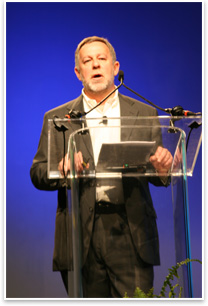 Reed said that we can start the design process by understanding life processes in each unique place we are building. Everything we design engages with the living system that it’s a part of—whether or not that engagement is planned or intentional. “It is by expanding our concept of design to include designing that engagement that we find the potential not only to sustain but to regenerate,” he said. “To develop something that contributes to the health and wealth of its place.” Reed said that we can start the design process by understanding life processes in each unique place we are building. Everything we design engages with the living system that it’s a part of—whether or not that engagement is planned or intentional. “It is by expanding our concept of design to include designing that engagement that we find the potential not only to sustain but to regenerate,” he said. “To develop something that contributes to the health and wealth of its place.”
Reed named three essential aspects that serve as a basis for creating a regenerative or healing relationship with place.
1. We need to first experience the whole system we are working within (often a watershed or two) and understand the potential it has to evolve to greater resilience and diverse relationships. This requires moving beyond performance standards and how the elements of a system behave to developing a pattern understanding of relationships.
Everything we design engages with the living system that it’s a part of—whether or not that engagement is planned or intentional
2. We need to relate this experience so other stakeholders can be inspired to appreciate the place as a living system. We call this a story of place. “A narrative or story is a powerful means of communicating complex relationships and engaging people in an understanding of how the pieces and subsystems in a place work together—we learn through metaphor,” Reed said.
3. Implement a continual dialogue process as part of the design and operation process to align the aspirations of the stakeholders with the nature of the place. “The process of regenerative design is a process of continually enriching dialogue among the designers, the community or organization, and the system the design is a part of, Reed said. This dialogue should be continual, necessitating establishment of a core team with key stakeholders whose job it is “hold and develop the understanding of life in that place—the evolving story.”
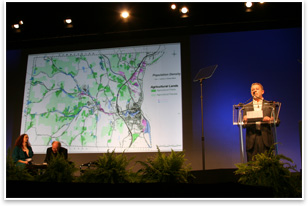 Some examples of living design Some examples of living design
Loreto Bay, on the Baja Peninsula on the Sea of Cortez, was settled by Europeans 500 years ago. They transformed this area from a scrub oak forest—originally with wetlands and streams—to a desert through farming and grazing.
By introducing the perspective of regeneration, the project team began to see that development at Loreto could be an opportunity to heal. The development was reorganized to regenerate the estuary and the water in the dry arroyos. “The urban pattern elaborated and enriched the edge between land and sea. The mangroves were replanted ... the upland watersheds are to be restored,” Reed said. “Based on other experience in dry-land systems, it is anticipated that ground water restoration, habitat, and even running water can be restored in as little as 2-10 years. The evidence exists in the upland area.”
The Brattleboro Co-op: A grocery store that wanted to build a high-performance LEED® building discovered that the energy expended in shipping food to the store was far higher than the energy used to operate the building—an average of 3,000 miles per bite of food in New England. Looking at the energies involved in the system as a whole, the co-op decided further to become a sponsor for local agriculture and regenerating the local, overused soil. “This ‘grocery store’ is re-programmed to grow into an agriculture and soil extension service, a cannery, a place for hunters to dress meat, a day-care center, a credit union,” said Reed. “The building process became a catalyst for a long-term and living system perspective for a 100-year plan for the co-op and the region.”
Reed concluded with “a thought to chew on”: we have the opportunity and imperative to evolve our thinking and practice in a way that can contribute to regenerating our planet. “This nature of work will require us to think more and more like living systems and embrace a whole-systems mind and design process in order to wholly participate in the system of life,” he said. “The role of architecture and development will be dramatically enriched and positive—plus it’s just plain, powerfully good fun.”
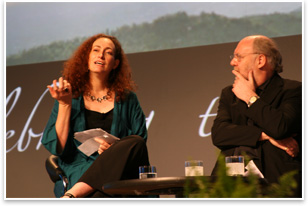 And furthermore… And furthermore…
Panel members further clarified their positions in response to Cole’s questions, as synopsized below:
How do we effect the fundamental value change that will enable us to design holistically?
Reed: It’s about eliciting values, not changing them. We need to elicit understanding and care beyond knowledge, and to explore essence—where does our heart speak? We must help people understand and participate in their systems, their homes. When they begin to understand their environments, they begin to love them.
Du Plessis: We need first to get rid of our old values. I think the idea is The Fountainhead author Ayn Rand’s fault, but we need to get rid of the idea that each building we design is a precious object. We need to let go of fixed notions of what is good and bad in architecture.
Cole: Nature is a co-equal partner. Are we expanding beyond the notion of individual buildings?
Du Plessis: We need to stop thinking of each building as individual. Think of a building as an island in the stream that gives back to the stream.
Reed: We also need to understand that property lines are a fiction. It’s about objects and the invisible relationships among them. Without those relationships, we don’t have a living system.
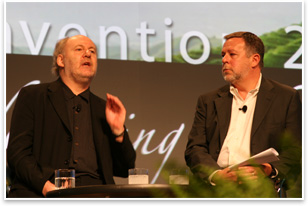 Cole: What about working with nature in an urban context? Cole: What about working with nature in an urban context?
Reed: It’s all nature—Vermont is as natural a landscape as is Manhattan.
Du Plessis: Create new regenerative processes. We need to realize that it is our role to be agents of regeneration in the name of health.
Cole: What positive steps can architects take?
Reed: Help expand the vision of your clients and allow more reflection time with them. Architects are in a unique position to help.
Du Plessis: Have an architectural, spiritual practice that spills into your everyday life. Don’t wait until everything is sorted out—just go out and start. If you don’t have an answer, ask Mother Nature—maybe she’ll help you. |


 Summary:
Summary: Du Plessis calls for a “new story”
Du Plessis calls for a “new story” Du Plessis noted that Thomas Berry, in
Du Plessis noted that Thomas Berry, in Reed said that we can start the design process by understanding life processes in each unique place we are building. Everything we design engages with the living system that it’s a part of—whether or not that engagement is planned or intentional. “It is by expanding our concept of design to include
Reed said that we can start the design process by understanding life processes in each unique place we are building. Everything we design engages with the living system that it’s a part of—whether or not that engagement is planned or intentional. “It is by expanding our concept of design to include  Some examples of living design
Some examples of living design And furthermore…
And furthermore… Cole: What about working with nature in an urban context?
Cole: What about working with nature in an urban context?